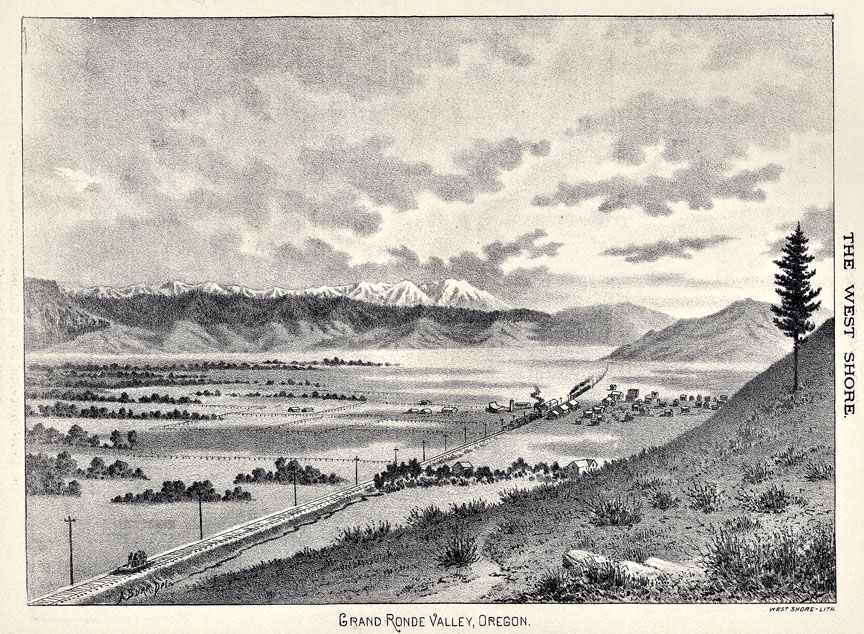- Catalog No. —
- OrHi 105242
- Date —
- January 1885
- Era —
- 1881-1920 (Industrialization and Progressive Reform)
- Themes —
- Environment and Natural Resources
- Credits —
- Oregon Historical Society
- Regions —
- Northeast Oregon Trail
- Author —
- The West Shore Magazine
Grande Ronde Valley, c.1884
This lithograph shows a portion of northeastern Oregon’s Grande Ronde Valley as it appeared in the mid-1880s. It was published in the January 1885 issue of The West Shore, a Portland-based magazine “devoted to the development of the Great West.”
Although the Oregon Trail had run through the Grande Ronde Valley since the 1840s, whites did not begin settling in the area until the fall of 1861, when a group of emigrants established two small settlements near what would eventually become the towns of La Grande and Union. The following spring, Conrad Miller planted the first orchard in the valley and Benjamin Brown plowed the first sod to be turned.
The newly established homesteaders found a ready market for their agricultural produce in the thousands of miners streaming through the valley on their way to the recently discovered gold fields of Idaho and Eastern Oregon. The population of the valley quickly grew as stockmen from the Willamette Valley came to graze their cattle and settlers from both east and west came looking for a new home.
By the end of the 1860s, the landscape of the Grande Ronde Valley had undergone a dramatic transformation. The valley’s first newspaper, the Sentinel, described the landscape in the spring of 1868: “The waste prairie has changed to fenced and cultivated farms, and in all directions the handiwork of intelligence and industry is visible. Comfortable houses and outhouses have been built, and orchards planted, while from the poor immigrant has sprung the well to do farmer.”
The lack of transportation proved to be a limiting factor in the valley’s growth, however. After years of lobbying by valley residents, the transportation problem was finally solved in 1883 when the Oregon Railway and Navigation Company built a railroad through the valley, connecting it to the markets of western Oregon and the eastern United States.
By the mid-1880s there were several growing towns in the valley, and most of the valley floor was under cultivation, growing wheat, barley, rye, potatoes, and fruit, while the uplands provided timber and livestock forage. The railroad provided the impetus needed for further development of the Grande Ronde Valley’s economy, and contributed to the transformation of the valley into the domesticated agricultural landscape that we see today.
Further Reading:
An Illustrated History of Union and Wallowa Counties. Spokane, Wash: 1902.
Written by Cain Allen, © Oregon Historical Society, 2005.
